IMAGE OF A BEAR IN PERCEPTION OF RUSSIANS AND SERBS (EXPERIENCES OF COMPARATIVE TYPOLOGY ON THE MATERIAL OF SOME GENRES OF FOLKLORE)
In the study, we seek to identify the characteristic features of the images of animals in the folklore of Slavic peoples. This article discusses the symbolic image of a bear based on the material of the main genres of Russian and Serbian folklore. As a totemic animal, the bear had an exceptionally important place in the world perception of Slavic people, and its role subsequently began to acquire additional meanings that significantly changed the attitude of representatives of different Slavic people to its position in relation to man. A comparative analysis of the image of a bear in Russian and Serbian folklore, conducted in this work, indicates the influence of a whole complex of factors in the formation of a picture of the surrounding world in Russians and Serbs.

















While nobody left any comments to this publication.
You can be first.
Dahl, V. I. (1905), Tolkoviy slovar’ zhivogo velikorusskogo yazyka [Explanatory Dictionary of the Living Great Russian Language], M.O. Wolf, SPb, Moscow, Russia [Online], available at: https://runivers.ru/bookreader/book483202/#page/162/mode/1up (Accessed 4 April 2019) (in Russ.).
Djordjevic, T. (1958), Priroda u verovanyu i predanyu nashega naroda [Nature in beliefs and legacy of our people], Serbian academy of science and arts, Belgrade, Serbia (in Serb.).
Ivanov, V. V. (1974), Issledovaniya v oblasti slavyanskih drevnostey [Research in the field of Slavic antiquities], Nauka, Moscow, Russia (in Russ.).
Karadzic, V. (1965), Sabrana dela. Kniga IX: Srbske narodne poslovitse [Collected works. Book IX: Serbian people proverbs] Prosveta, Belgrade, Serbia (in Serb.).
Mify narodov mira: entsiklopedia [Myths of the peoples of the world: encyclopedia] (2008), in Tokarev, S. A. (ed.), Moscow, Russia [Online], available at: https://archive.org/details/Myths_of_the_Peoples_of_the_World_Encyclopedia Electronic_publication_Tokarev_and_others_2008/page/n15 (Accessed 4 April 2019) (in Russ.).
Mokienko, V. M., Nikitina, T. S. and Nikolaeva, E. K. (2010), Bolshoy slovar’ russkikh poslovits [Great Dictionary of Russian proverbs], Olma Media Group, Moscow, Russia (in Russ.).
Otašević, Đ (2012), Frazeoloshki rechnik srpskog yezyka [Phraseological dictionary of Serbian language], Prometey, Novi Sad, Serbia (in Serb.).
Radenković, Lj. (1996), Simbolika sveta u narodnoy magiyi Yuzhnykh Slovena [Symbolism of world in the folk magic of southern Slavs], Prosveta, Serbia (in Serb.).
Slavyanskie drevnosti: etnolingvisticheskiy slovar’ v 5 t. Tom 3: K-P [Slavic antiquities: ethnolinguistic dictionary in 5 volumes. Volume 3: K-P] (2004), in Tolstoy, N. I. (ed.), Mezhdunarodnye otnosheniya, Moscow, Russia (in Russ.).
Vasmer, M. (1986), Etimologicheskiy slovar’ russkogo yazyka. V 4 t. Tom. 2 (E - Muzh) [The Etymological Dictionary of the Russian Language. In four volumes. Vol. 2 (E - Muzh)], Translated by Trubachev, O.N., Progress, Moscow, Russia (in Russ.).
Vukajlija [Online], available at: https://vukajlija.com/mecka (Accessed 4 April 2019).
Zimin, V. I. and Spirin, A. S. (1996), Poslovitsy i pogovorky russkogo naroda [Proverbs and sayings of Russian people] Syuita, Moscow, Russia (in Russ.).